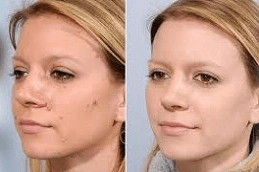Quick Facts:
- Removal for cosmetic reasons: 80-90%
- Cost: Ranges from 300 AED to 700 AED
- Duration of session: 5-15 minutes
- Satisfaction rate: 85%
- Effectiveness of cryotherapy: 90%
- Complication: 85-90% does not observe any complication.
- Downtime: Minimal, or for 1-2 days
- Back to desk work: Within 1-2 days
- Target: Eliminating the benign mole
- Outcome: Aesthetic and mole-free skin
- Treatment type: Surgical, non-surgical
Moles are an example of pigmented lesions. Lesions that are benign or non-cancerous can be left alone. However, if your mole causes you any discomfort, your consultant may advise you to get it removed. If the color of a mole changes and grows darker, it implies that the cells that make up the mole have a lot of melanin or pigment. With a Benign Mole Removal Treatment in Abu Dhabi, you can have harmful or malignant moles removed as well as non-cancerous or benign moles removed at a facial cosmetic surgery.
Table of Content
Benign Mole:
Melanocytes are noncancerous skin cells that develop in clusters. The pigment that gives humans a tan is produced by these melanocytes responsible for normal skin coloring. The amount of pigment produced by the melanocytes in the skin lesion determines whether the mole is skin-color or brown. They can either be elevated or flat.
Benign Mole Removal Treatment:
Benign Mole Removal Treatment focuses on completely removing the moles from the skin. Depending on the customized circumstances, surgical or non-surgical treatments are used to do so. While considering cosmetic aspect and not leavinng any mark or sign on the skin.
Cost:
Benign mole removal cost ranges from 300 AED to 700 AED. Several factors impact the actual cost. The doctor will determine it at the initial consultation after doing a thorough examination.
Characteristics:
The following aspects are considered while studying the characteristics of moles:
Asymmetry: Symmetrical structure
Border: Even borders
Color: Only one consistent color
Diameter: Normally smaller in size
Evolving: Stay the same over time
Types of Benign Moles:
Following is a brief explanation of the types of moles:
| Type | Explanation |
| Common nevi (moles) | Small, evenly colored and round. |
| Congenital nevi | Moles present at birth. |
| Compond nevi | Pigmentaed and slightly raised moles. |
| Atypical nevi (dysplastic moles) | Large, irregular with varied colored. |
| Spitz nevi | Red or pink colored, dome-shaped often found in children. |
| Junctional nevi | Pigmented and flat moles. |
| Intradermal nevi | Often flesh-colored, raised structure and dome-shaped. |
Treatment Options:
The following methods are considered while undergoing the treatment:
Excision:
Using a knife or special surgical scissors, excision, also known as cutting, includes removing the mole and a small skin margin.
Your doctor will inject a topical anesthetic into the mole before cutting it out to make the removal process as painless as possible. Your doctor may need to use stitches to heal the wound after removing your mole if it has grown deep into the skin.
Surgical Removal:
A mole excision is akin to the surgical removal of a mole. Your doctor will shave off layers of the mole with a knife until it is gone.
Your doctor will give you a local anesthetic to numb the region so you don’t feel any discomfort before shaving. After this sort of mole removal, stitches are typically not required, but the skin may have a little pink area where the mole used to be.
Laser Mole Removal:
Lasers can be used to treat certain moles. This is most typically done on non-cancerous moles that are tiny and flat. Your doctor will utilize bursts of light radiation to remove the mole tissue during laser removal.
Laser therapy may require two or three treatments to eliminate a mole. If moles are in difficult-to-reach places, such as the ears, or on sensitive or highly visible skin regions, such as the face, laser treatment may be a viable alternative. Lasers can also be used to remove many moles simultaneously.
Freezing:
Non-cancerous moles that only exist on the skin’s surface can be frozen away. If you and your doctor decide that freezing your mole is the best way to get rid of it, your doctor will use liquid nitrogen to accomplish it. You can have a little blister where the mole is on your skin.
Results:
Typically, the outcomes are great, and virtually all patients are satisfied. The safety and effectiveness of this form of surgery have been proven through research. The majority of our patients report that they can live life to the fullest after removing a conspicuous or suspicious mole.



Ideal Candidate:
You’re a good candidate for mole removal if you’re unhappy with the look of a mole or are worried that an oddly shaped or pigmented mole could be cancerous.
Regardless of age, skin type, or skin tone, most people find the treatments safe and effective.
Male and female patients have benefited from rapid, painless removal from any body region with no downtime and simple, speedy recovery.
During your initial visit, if you have any questions regarding your candidacy, one of our doctors can assist you in determining whether this treatment is correct for you.
Do Moles Need Treatment?
Moles are a type of skin growth that is quite typical. Non-cancerous, malignant, and borderline tumors are all possible. Non-cancerous moles may not necessarily need to be removed. However, some people prefer to have their moles removed whether or not they are cancerous or have the potential to become cancerous.
Your primary care physician may be able to remove non-cancerous moles in some cases. When a mole is benign, it is normally removed in a minor office operation that takes only a few minutes in your doctor’s office.
How to Choose the Right Method?
The following aspects are considered before selecting a treatment method:
- Mole characteristics and location.
- Medical history.
- Expected outcome.
- Recommendation by the specialist, etc.
Preparation:
A specialist will assess the color, size, and look of the mole or moles treated at the first appointment to discuss mole removal.
They’ll also look at your skin type and recommend surgical treatment for you.
After this essential evaluation, they will advise you on the best surgical solution for your specific moles and health.
Aftercare:
- After your operation, you should be able to go home right away. If you experience any pain after your mole removal, you can take over-the-counter pain relievers like paracetamol.
- Your consultant or general practitioner will inform you of the analysis results.
- Following mole removal, your surgeon may ask you to return a few days later to examine the incision and replace the dressing.
- If the wound turns red, puffy, or starts bleeding, make an appointment with your surgeon or the Outpatient Department.
- Unless your job places a strain on the area repaired, you should be able to return to work the next day. Make sure to talk to your surgeon about your return to work.
- Depending on what region was sewn, you will need to contact the doctor or the practice nurse to remove your sutures.
How to Manage the Skin and Avoid its Recurrence?
The following aspects are helpful to maintain the cosmetic appearance of the skin:
- Avoid exposure to sunlight.
- Monitor the changes within the skin.
- Apply gentle skincare.
- Attend follow-up appointments, etc.
Benefits:
The following benefits are attained after going through the treatment:
- Enhanced cosmetic appearance.
- Elimination of irritation and painful sensation.
- Prevent further recurrence of the moles.
- Restoring the aesthetic and youthful structure of skin.
- Following customized treatment pattern, etc.
Book Us to Eliminate Moles Forever!
If you are looking for Benign Mole Removal Treatment in Abu Dhabi, contact Enfield Royal Clinic by filling out the consultation form below and book a free first appointment.
FAQ’s:
Is Mole Removal Necessary for all Benign Moles?
No, it is not necessary to remove the benign moles.
What Topical Components are Helpful in Removing the Moles?
Topical treeatments normally does not effect the moles.
Is the Procedure Painful?
No, the procedure is not painful at all.
Are Benign Mole a Threat to Health?
95% of them are not a threat to health conditions.
When Will I Observe Initial Outcome after the Session?
Initial outcome is observed immediately after the session.
Is There any Sign or Mark Observed on the Skin After the Session?
No, there is not any mark or sign observed on the skin.
How Long Will the Outcome Last?
The outcome is likely to be permanent after the session.
What are the Side Effects of Benign Mole Removal Treatment?
Infection, or unbalanced coloration is observed after the session.
Can a Mole Recur After the Session?
Yes, it can recur if proper measures are not followed.
Is There any Discoloration Observed after the Session?
Yes, temporary discoloration is observed after the session.
What is the Difference Between the Removal of Mole for Cosmetic and Medical Reasons?
Cosmetic treatment only aesthetically enhances the skin, while the one focuses on treating the underlying health issues too.
Can I Resume the Normal Activities Right After the Session?
For a personalized response, it is better to consult a specialist.
Are Multiple Moles Removed Within One Session?
Yes, multiple moles can be removed within one session.
Is There any Age Range to Sign Up for the Treatment?
No, there is no specific age range to sign up for the treatment.










 Start
Start